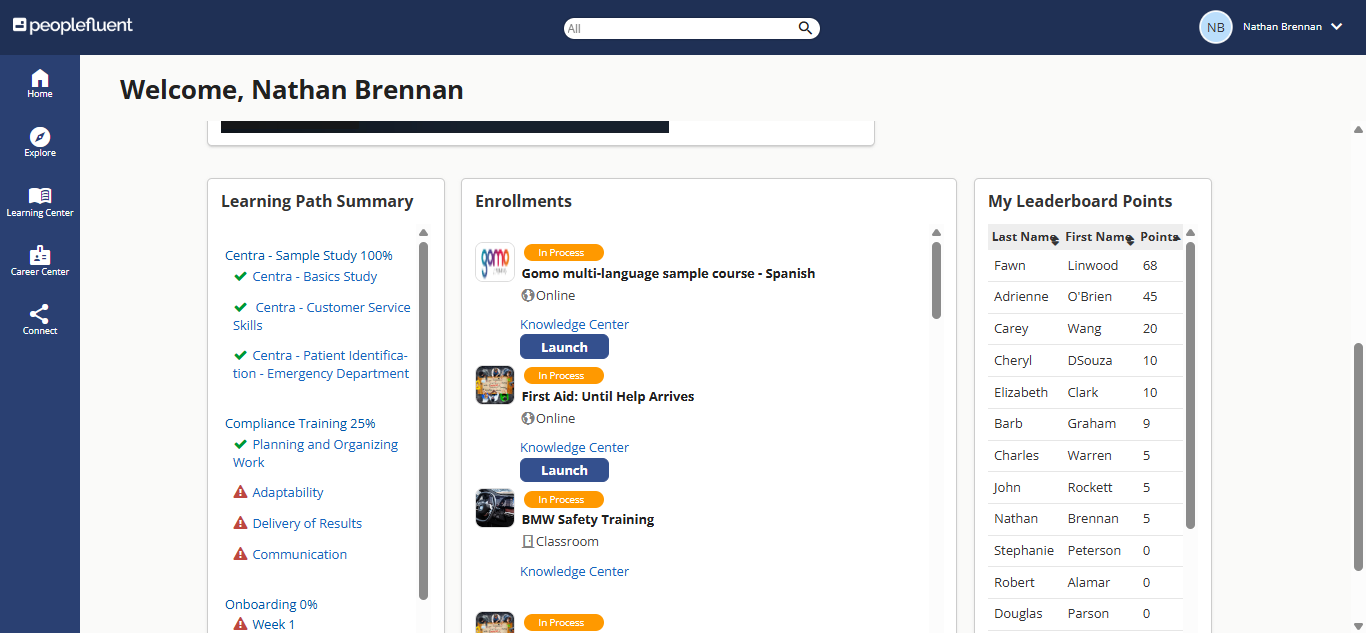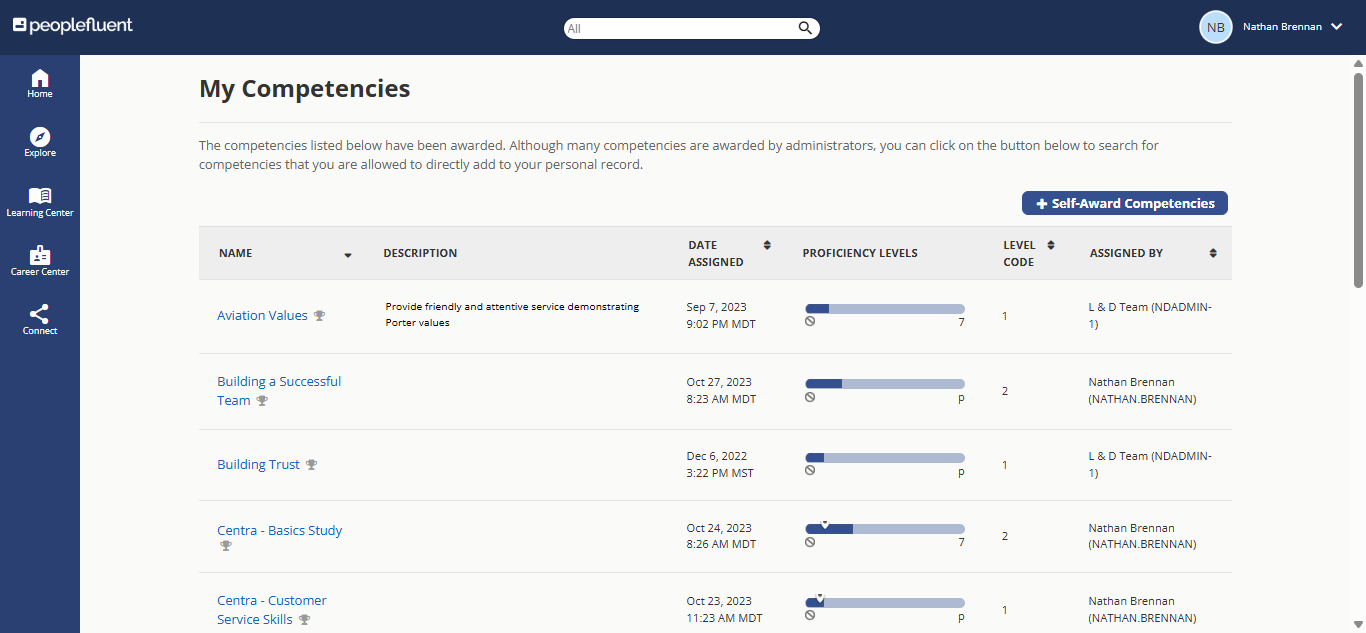Published: May 8, 2025Time to read: 10mins Category: Learning
How to Shape Talent Development Around Your Business Priorities
Table of Contents
Research suggests that more than half of organizations fail to execute the overarching business goals they spend significant time and effort formulating—small wonder when 67% of key functions are not aligned with corporate strategies. So how can talent development professionals ensure their work is informed by a complete understanding of the business’s goals?
In this article, we’ll look at how to undertake this necessary synchronization process, helping you better understand what makes your C-Suite and your sales, delivery, and other teams tick—while ensuring you’re offering a real return on investment through your learning programs.
How Learning, Talent, and Business Priorities Intertwine
A business strategy takes many different forms. One of the following probably describes the main goals of your organization:
- Expanding market share
- Introducing new goods or services into the market
- Addressing a market gap that competitors aren't covering
- Continuing to grow revenue and sell more
- Innovating in the market
For each goal, there’s a corresponding set of roles and competencies that are most critical. If your goal is to sell more, obviously your salespeople have a significant direct role—but that doesn't mean they're the only point of leverage you have. For example, they can only sell the products you design, build, and offer—so those teams would also have to be factored in.
Identifying these critical roles and competencies enables the creation of targeted learning paths that focus on the skills development that drives organizational success. Many larger companies will begin such an exercise already having somewhat intricately designed and rationalized organizational structures, job descriptions, roles, and criteria. Smaller companies, meanwhile, may rely on outsourcing for that capability, but they still need to hire and develop people with certain goal-aligned skillsets.
Learning tools can help you both understand and shape the core competencies individual positions and jobs should have within this structure. An appropriately robust LMS will:
- Allow you to assign skills and competencies to job profiles
- Serve employees customized learning experiences based on their needs
A flexible LMS will also help you respond when those all-important business priorities change to reflect new realities. Even though you're setting up all these competencies, job roles and skillsets, you and your tools still have to be capable of adapting. Your company might get acquired or you might acquire another company, new products or services may come along, or you may experience explosive growth. You have to plan for the future, but also build for the now.
READ MORE ON ADAPTING TO CHANGING BUSINESS PRIORITIES | ‘5 Ways to Ensure Talent Management Consistency During Acquisitions’
How to Build a Role-Based Talent Development Program
When some organizations talk about role-based development, it may be defined in terms of a job profile for a very specific role, or as incorporated at a higher level such as within a job family. Taking the time and effort to outline the required skills needed for a specific job role is a heavy lift, but organizations in highly regulated industries often find it necessary from an auditing perspective or due to internal requirements.
In order to create a role-based talent development program, you’ll want to determine a very clear set of skills, competencies, and learning modules that will enable you to build out definitions in your LMS, and define the tracking components necessary for keeping tabs.
In terms of skills, you’ll need to:
- Define a set of stages and objectives that move people from beginner elements through advanced elements and, ultimately, mastery
- Use commonly understood language for roles and responsibilities, avoiding jargon that has little meaning outside of your organization
- Settle on whether you’ll work on an individual role or job family basis
- Describe the critical thinking and reasoning skills the learner will need to use in the learning process and in subsequent on-the-job application
- Define criteria for your evaluators or preceptors—are the coaches and instructors also responsible for evaluation? What stages will they be involved in?
- Determine how you will evidence learning. While this is relatively straightforward in formal classroom training or online courses, consideration must be given to how the success of practical demonstrations and tasks will be tracked in your systems.
Competencies serve as a kind of benchmark for evaluating employee performance, and can help managers determine an individual’s proficiency level. In an LMS, you can actually have a graphical scale to track this competency. This scale can be as simple as whether someone met or did not meet the objectives of a particular skill, or it could have multiple levels with increasing degrees of mastery.
In many organizations, especially those in the healthcare industry, there has historically been a reliance on paper-based checklists to track this information. PeopleFluent has experience with transitioning these to an electronic format, but this does require that the employees are made to understand the importance of tracking objectives and completions, whether in the classroom, via one-to-ones, or supervisor assessment.
Whatever you track in your LMS, you’ll be able to report on. An LMS will make external reporting quick and easy from a compliance perspective, but you’ll also be able to analyze the data and work out whether you’re meeting your business goals. You’ll also be able to see any training gaps or areas where learners are struggling to attain competency.
HAND-PICKED FOR YOU | ‘7 Benefits of Skills Assessments When Optimizing Your Talent Strategy’
Visualizing Learning Paths and Availability Within PeopleFluent’s LMS

When tracking skills, an LMS can be used to create tailored learning paths based on the competencies required for each job role. Within PeopleFluent Learning, a learning path is a graphical representation of the skills needed for a particular competency, job role, or job family.
The advantage of these learning paths is that they outline the competencies and specific learning modules involved in each job profile. When an employee wants to work on a specific skill, they know they can take an online course, and understand how the system will track completion of that task towards their goal. They also intuitively understand what’s next in the process. The longer and more detailed the paths you’re able to define, the more leverage you and your employees will have when working toward longer-term goals. This helps your organization with issues such as succession planning.
As an individual works toward a specific objective, these learning paths will help structure their supervisor’s conversations. The supervisor can also use the paths to determine other skills that might be necessary, adding additional learning modules or other learning paths that they feel are relevant.

PeopleFluent’s LMS also provides a workforce planning tool that gives you the ability to see who in your organization has the required skills and training for a specific job or task. This view is dynamic—it’s automatically updated as new competencies are attained by individuals in the system—and ensures that supervisors can quickly and easily respond to time-sensitive needs. It also helps them run future scenarios informed by your strategic objectives and consider where they would experience skills shortfalls. Once these shortfalls are identified, they could be addressed ahead of time by assigning employees to certain learning paths.
MORE TALENT MANAGEMENT INSIGHTS | ‘6 Ways of Enhancing Continuous Feedback Within the Workplace’
Tool-Based Approaches to Closing Skills Gaps
Your LMS should, like PeopleFluent Learning, offer various methods for assessing your current employee capabilities. Once the nature of the gap is identified along with the individuals who are best positioned to attain the required competencies, you need to understand the learning materials and tools you have available to you. This could include:
- Existing learning content libraries
- New learning content that you develop in-house
- Content offered by third-party learning providers
- Instructors (internal or external) available to deliver content
The platforms you work within must also support an assessment cycle that helps you understand how the gaps you identify are being addressed. Some key LMS tools that will help you assess skills gaps include:
- Competency frameworks and mapping
- Skills assessments and quizzes
- Self-assessments
- Simulations and scenario-based assessments
- Learning path completion tracking
- Competency-based reporting and dashboards
- 360-degree feedback tools
- Performance appraisals
Naturally, you can mix and match these tools in order to find and address your gaps.
When any gap is discovered, it’s important to determine how urgent it is to actually address it. It stands to reason that you only really need to concentrate on closing gaps that have the biggest detrimental impact on your business—the gaps that are keeping you from really successfully achieving the business goals you’ve identified. Your learning tools have a role to play in this determination, alongside other systems in your wider ecosystem. Data sources could include:
- Competency mapping and job role analyses
- Employee assessments and evaluations
- Business performance metrics and KPIs
- Customer feedback and satisfaction scores
DISCOVER THE BENEFITS OF A SKILLS PLATFORM | ‘4 Ways AI Can Refine and Scale Your Skills Enablement Strategies’
Real-World Examples of Role-Based Development Programs
PeopleFluent has worked with a number of businesses to create talent development programs shaped by business priorities. The following short case studies demonstrate organizations with a solid grasp of the job profile/job families that we’ve worked with.
A Large Healthcare Organization
This PeopleFluent client was successful in onboarding nurses, however it was taking months to do so. The client identified job families and associated them with specific behaviors and skills (such as bedside manner, company values, or specific technical skills). They moved from paper-based records of evaluation to an online system wherein supervisors could easily assign particular job skills for development and validation. Once the initial heavy lifting of defining the job families was done, they were able to bring onboarding time down first from months to just two weeks, and then to just a couple of days.
A Large Transportation Servicing Company
Safety is paramount for this PeopleFluent customer. Before employees are permitted to perform certain tasks, they must not only do the safety training, they must be assessed by a supervisor who looks over their shoulder and makes sure they’re doing it correctly and safely. They’re also required from an outside agency perspective to make sure that all the requirements are being met and reported. However, this industry has a high turnover rate and supervisors were getting exhausted by the high degree of retraining involved.
PeopleFluent was able to automate the onboarding process. When new people would come onboard, they would be assigned appropriate role-based safety and compliance learning, and supervisors could validate whether individuals were performing the tasks correctly in the system. The system would then schedule annual recertification training to ensure compliance was maintained.
RELATED READING TO DOWNLOAD TODAY | ‘Putting Impact-Backed ROI at the Heart of Your Learning Ecosystem’
Evolve Your Approach to Talent Development With PeopleFluent Learning
Taking a role-based development approach to your talent can help you better address your skills gaps and overarching organizational goals. PeopleFluent Learning’s learning path and workforce planning capabilities help your organization adapt to changing market conditions and the ebb and flow of the labor market. Request a demo today, or contact us for more information.